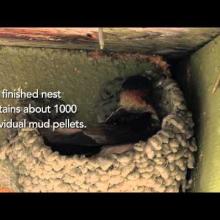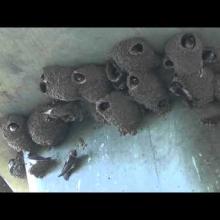

Join BirdNote tomorrow, November 30th!
Illustrator David Sibley and actor H. Jon Benjamin will face off in the bird illustration battle of the century during BirdNote's Year-end Celebration and Auction!
Cliff Swallows gather in spring, in nesting colonies of up to 3,700 nests. Look for swarms of them under bridges, under the eaves of barns, or even the side of your house. The swallows use mud to make gourd-shaped nests - side by side and jumbled together. Watch the video! And Cliff Swallows consume hordes of flying pests. For more about this bird, visit Cornell's All About Birds. You can learn about bugs that aren't pests at Audubon.org.
BirdNote®
Cliff Swallow--Strength in Numbers
Adapted from a script by Frances Wood
This is BirdNote!
[Flight calls of Cliff Swallows]
[More Cliff Swallow flight calls]
Cliff Swallows have returned from wintering in South America, and they’re gathering in nesting colonies. A single colony in the West may contain up to 3,700 nests. In the East, colonies are generally a bit smaller. Look for swarms of these swallows under bridges, on cliffs, under the eaves of barns, or even the side of a house.
[Sound of a large colony]
They construct their gourd-shaped nests out of mud, side-by-side and all jumbled together. One parent usually guards the nest, often peeking out of the round opening, showing its creamy-white forehead-patch.
[Sounds of colony continued]
Cliff Swallows consume hordes of flying insects. [Insects]
These birds have only five different calls, but one—a unique “squeak call”—tells others that they’ve found food. [Song contains squeak call] So, when one bird finds a swarm of insects, it spreads the word to its neighbors, perhaps part of the reason these birds thrive in large colonies.
[Song of the Cliff Swallow continued]
Find out about bird-friendly ways to garden when you come to our website, BirdNote.org.
Support for BirdNote is provided by Jerry Tone and Martha Wyckoff from Seattle, Washington — and generous listeners around the world.
###
Bird sounds provided by The Macaulay Library at the Cornell Lab of Ornithology, Ithaca, New York. Flight call [107569] recorded by D.S. Herr; calls at a large nesting colony [111118] T. Sander; song with squeak note [105668] by G.A. Keller.
Producer: John Kessler
Executive Producer: Chris Peterson
© 2011 Tune In to Nature.org May 2011/2021 / June 2023
Narrator: Michael Stein
ID# (old: 050405CLSWKPLU) CLSW-01c-2021-5-2






